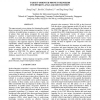Free Online Productivity Tools
i2Speak
i2Symbol
i2OCR
iTex2Img
iWeb2Print
iWeb2Shot
i2Type
iPdf2Split
iPdf2Merge
i2Bopomofo
i2Arabic
i2Style
i2Image
i2PDF
iLatex2Rtf
Sci2ools
ICASSP
2008
IEEE
2008
IEEE
Target-oriented phone tokenizers for spoken language recognition
This paper presents a new strategy for designing the parallel phone recognizers for spoken language recognition. Given a collection of parallel phone recognizers, we select a subset of phones from each phone recognizer for each target language to construct a target-oriented phone tokenizer (TOPT). As a result, the collection of target-oriented phone tokenizers is more effective than the original parallel phone recognizers. This approach improves system performance significantly without requesting for additional transcribed training samples. We validate the effectiveness of the proposed strategy within the framework of the parallel phone recognizer followed by vector space modeling backend, or PPR-VSM. We achieve equal-error-rate of 2.21% and 3.65% on the 2003 and 2005 NIST LRE databases, respectively, for 30-second trials.
ICASSP 2008 | Original Parallel Phone | Parallel Phone Recognizer | Signal Processing | Target-oriented Phone Tokenizers |
Related Content
| Added | 30 May 2010 |
| Updated | 30 May 2010 |
| Type | Conference |
| Year | 2008 |
| Where | ICASSP |
| Authors | Rong Tong, Bin Ma, Haizhou Li, Engsiong Chng |
Comments (0)

